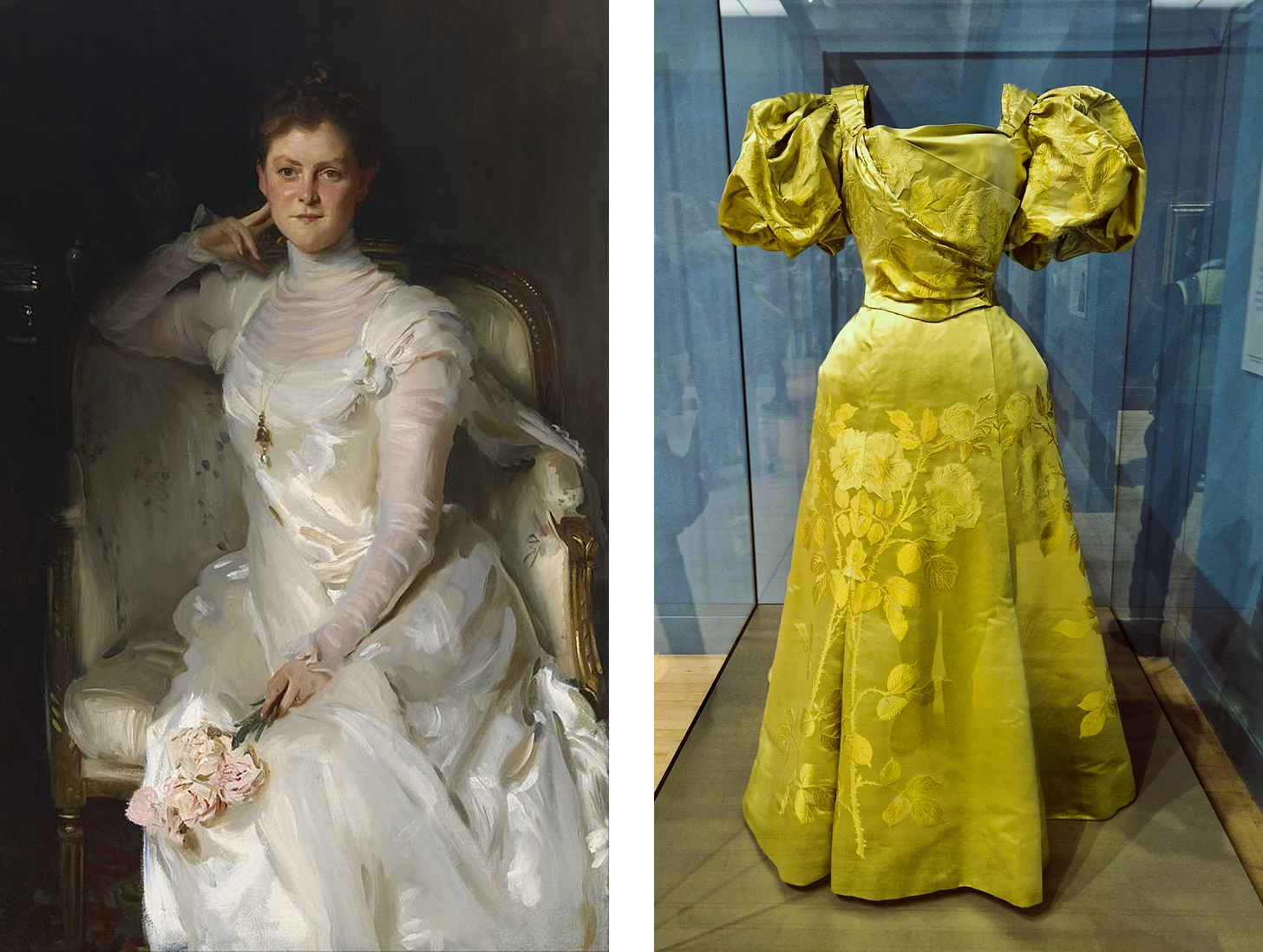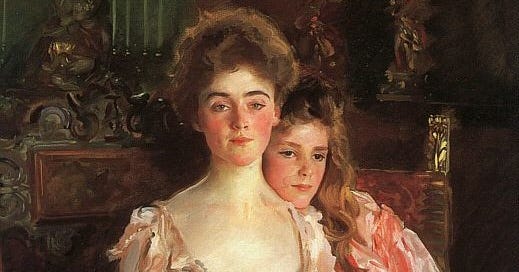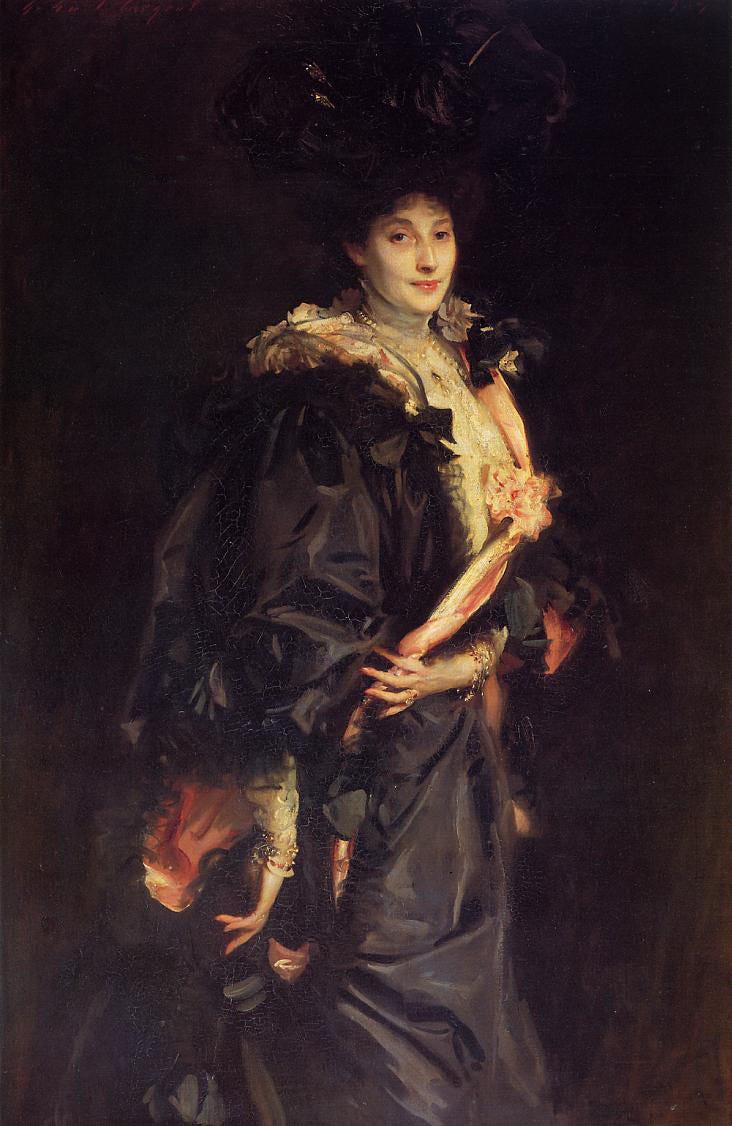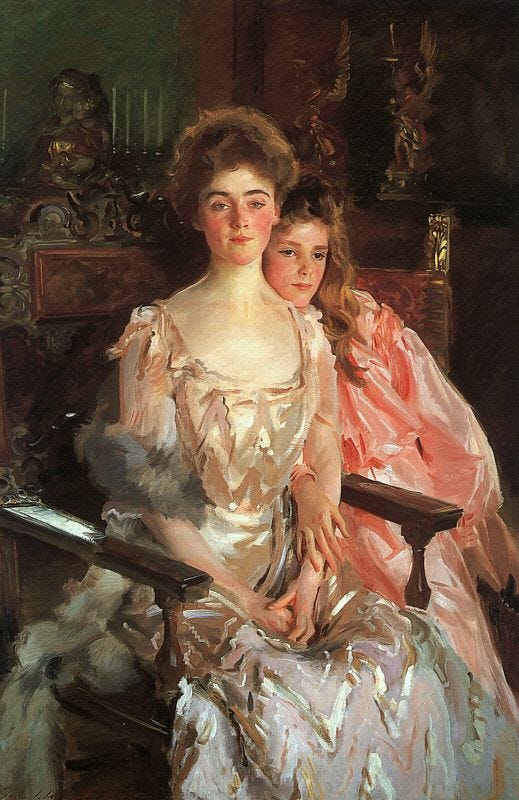Fashion In Art: John Singer Sargent
In this iteration: portraits, legacy and who tells your story
Hey Matryoshkas,
Back in March, I took myself on a day trip up to London to see the Tate Britain’s exhibition Sargent and Fashion (22 February – 7 July 2024). The museum has gathered a vast array of Singer Sargent’s portraits – almost 60 – and arranged them for display alongside numerous garments and accessories from the same time period (including some of the very same clothes worn by the subjects of said portraits!) As a long-time fan of Sargent’s work – I had some postcards of his portraits blu-tacked on my wall in my student halls when I was in undergrad, and often liked to daydream about what sort of lives his subjects might have led – I of course had to go along.
I had a wonderful time there, browsing the galleries, and I came away with much to think about. Finally, I’ve been able to set my thoughts into words.
From the exhibition’s website copy:
“Sargent used fashion as a powerful tool to express identity and personality. He regularly chose the outfits of his collaborators or manipulated their clothing. This innovative use of costume was central to his artwork – for example, tugging a heavy coat tighter around a man to emphasise his figure or letting a dress strap sensuously slip from a woman’s shoulder. It was these daring sartorial choices that allowed him to express his vision as an artist.”
This decision-making on Sargent’s part is repeatedly emphasised throughout the exhibition, on plaques beside the paintings which grant a glimpse behind the scenes. But reading it back now, having seen the exhibition myself, I have to ask – when the plaque proclaims “Sargent used fashion […] to express identity and personality,” – whose identity and personality was he expressing?
I don’t think it was his sitters’.
What struck me as I walked the galleries, reading each plaque and gazing into the faces of each painted lady – feeling, as I did, that they looked real enough to step out of their paintings and speak to me – was this repeated situation: the sitter would choose the garment they wished to be painted in, or come up with several ideas. Sargent would then flout these suggestions in favour of his own ideas about what would become them.
Of his portrait of Lady Sassoon (Aline de Rothschild) – one of the first we see – the plaque notes, “Sargent posed Lady Sassoon wearing the taffeta opera cloak displayed nearby, to which pink roses were pinned. Her ensemble was completed with a string of pearls, bangles on both wrists, and a spectacular hat of black ostrich feathers.”
This opera cloak – a severe black on the outside – was carefully arranged so that a thick stripe of its pink lining was visible, cutting through the portrait for dramatic impact. The portrait is a very flattering one; the clothes were her own, very stylish, and Sargent’s stylistic choices flattered her. Sitters like Lady Sassoon appreciated their painters’ advice on what looked good in oil: “The rapport between fashion and painting was well understood at this time,” the exhibition plaques tell us. “As one French critic noted, ‘there is now a class who dress after pictures, and when they buy a gown ask, ‘will it paint?’’” But this arrangement of Sargent’s, when compared to some of his other costuming decisions, seems relatively subtle.
Moving on to a second example:
“When Sargent came to see Eleanora Iselin about her portrait, she had her maid display several of her most fashionable Parisian gowns,” notes the plaque beside Iselin’s 1888 portrait. “But Sargent decided to paint her in what she happened to be wearing: a black day dress suitable for receiving visitors at home.”
Now, Iselin’s portrait was – like the rest of Sargent’s portfolio – excellently crafted… but this wasn’t the image of herself she wanted to project to the world. She wanted to be shown as a woman of fashion, elegant and expensive, while Sargent’s vision framed her in a far less polished light, dressed for domesticity and comfort. If it were me, I’d have been quite annoyed.
Another example, from the 1899 portrait of Mrs Joshua Montgomery Sears (Sarah Choate Sears): “Her white dress in this work may have been chosen to complement [her daughter]’s portrait, or to indulge Sargent’s love of painting white. This, however, does not hint at Sarah’s own love of colour, as shown by her electric green evening gown displayed nearby.”

Sears looks undeniably beautiful in her portrait. But she doesn’t look like herself. Looking from one to the other, I could hardly picture the smiling face in the portrait wearing that riotous chartreuse gown, but wear it she did!
And from the 1903 portrait of Mrs Fiske Warren (Gretchen Osgood) and her daughter Rachel: “Gretchen supposedly intended to wear a favourite green velvet gown, but Sargent insisted she wear pink, thinking of her colouring against the red and gold splendour of the setting. She apparently borrowed her sister-in-law’s gown, which did not fit, and Sargent draped a piece of pink fabric around Rachel and styled it as a dress.”
“Sargent would intervene in a way that was much like a stylist or an artistic director,” says the exhibition’s curator, James Finch, in this article from Harper’s Bazaar. He’s completely right. It’s important to remember though, when considering Sargent’s choices, that these portraits were not being commissioned by fashion houses to promote their wares. Instead, they were commissioned by the subjects (or the subjects’ families), as symbols of culture, wealth and status. If Sargent was to be teleported forward through time and put in charge of a modern-day fashion editorial, his affinity for colour and arrangement would be exactly what was needed; presenting the clothes in the best possible light is an editorial shoot’s primary objective. Flattering – and making a statement about – the sitter is secondary, if it’s considered at all.
But Sargent’s fin-de-siècle sitters weren’t mere dolls, there to model clothes. They were people with personalities, and they cared what their portrait was going to say about them. (Understandable, when a portrait cost as much as it did, and portrait artists of Sargent’s calibre were in constant demand but could only take on so much work at a time.) The exhibition considers it “a measure of Sargent’s achievement that, while the lives of many of his sitters are little-known today, his images of them endure.” In other words, in setting their images to canvas, Sargent played a key role in deciding who each sitter would be remembered as.
I ask you now to consider this quote from Virginia Woolf’s Orlando (1928):
“Vain trifles as they seem, clothes have, they say, more important offices than merely to keep us warm. They change our view of the world and the world’s view of us. […] There is much to support the view that it is clothes that wear us and not we them; we may make them take the mould of arm or breast, but they mould our hearts, our brains, our tongues to their liking.”
Woolf is talking about gender – something Sargent often played with in his portraits, showing women in masculine getup; men in softer, more androgynous attire – and how the clothes one dons in their performance of gender affects the way they behave and the way others perceive them. It’s a sentiment that precedes Judith Butler’s theory of gender performativity (Gender Trouble, 1990) and – in a way – helps to make room for it. In the context of portraiture, though, this quote takes on further significance. If clothes “change our view of the world and the world’s view of us,” then what do the clothes in portraits like these say to the world about their sitters? How does this affect the sitter’s legacy – especially when the sitter doesn’t get to choose?
If this article has piqued your interest, Sargent and Fashion will continue running at the Tate until the 7th July; you can grab tickets here.
Until next time,
Holly
The Doll House







JSS is one of my favorite painters, and I'm terribly sad I don't live in London to be able to see this exhibit. His portraits are striking in their composition and technical execution and I'm glad the curators highlighted the stylist/art-direction aspect of his subject/sartorial arrangements in his works. Thank you for a lovely read, Holly!
Oh, I would have loved to see this exhibition in person - not really familiar with John Singer Sargent but I've always found the few portraits I've seen very arresting - and thanks for this mini tour! I wonder how he compared to other portrait artists of his day and whether his approach helped the subjects stand out from the crowd they undoubtedly wanted to impress? Maybe it's like commissioning the late Peter Lindbergh to take your portrait but being annoyed that he only wanted to do it in black and white...
That said, I would be annoyed if my portraitist had no interest in capturing my personality or preferences -- probably would have gone with someone else!